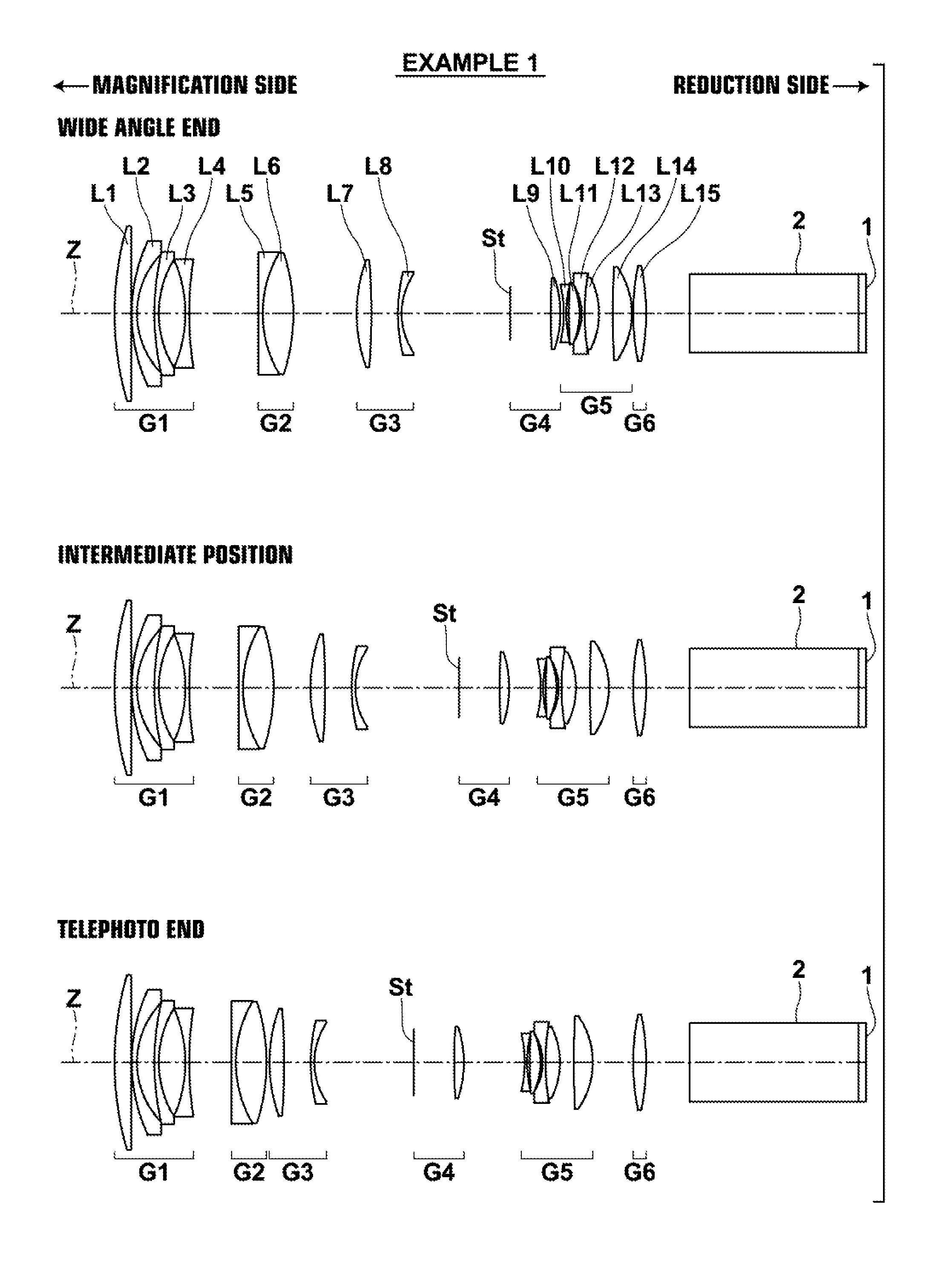Projection zoom lens and projection type display device
a projection zoom and display device technology, applied in the field of projection zoom lenses, can solve the problems of short back focus of this projection zoom lens, difficult correction of field curvature and distortion, and inability to equip with a mechanism for maintaining numerical aperture constant,
- Summary
- Abstract
- Description
- Claims
- Application Information
AI Technical Summary
Benefits of technology
Problems solved by technology
Method used
Image
Examples
example 1
[0158]The lens configuration of a projection zoom lens of Example 1 is illustrated in FIG. 1. FIG. 1 illustrates the positions of lens groups of a projection zoom lens according to Example 1 of the present invention at a wide angle end, a telephoto end, and an intermediate position between the two. Because a description has already been given regarding FIG. 1, redundant descriptions will be omitted here.
[0159]The projection zoom lens of Example 1 consists essentially of: a first lens group G1, which is provided most toward the magnification side, has a negative refractive power, and is fixed while changing magnification; a second lens group G2, which is positioned at the reduction side after the first lens group G1, has a positive refractive power, and moves while changing magnification; a third lens group G3 which is positioned at the reduction side after the second lens group G2, has a positive refractive power, and moves while changing magnification; a fourth lens group G4 which ...
example 2
[0175]FIG. 2 illustrates the arrangements of lens groups of the projection zoom lens of Example 2 at the wide angle end, an intermediate position, and the telephoto end. In Example 2, a first lens group G1 is constituted by four lenses, which are a positive first lens L1, a negative second lens L2, a negative third lens L3, and a negative fourth lens L4, provided in this order from the magnification side. A second lens group G2 is constituted by two lenses, which are a negative fifth lens L5 and a positive sixth lens L6, provided in this order from the magnification side.
[0176]A third lens group G3 is constituted by two lenses, which are a positive seventh lens L7 and a negative eighth lens L8, and an aperture stop St, which is a variable stop, provided in this order from the magnification side. A fourth lens group G4 is constituted by two lenses, which are a positive ninth lens L9 and a negative tenth lens L10, provided in this order from the magnification side.
[0177]A fifth lens g...
example 3
[0183]FIG. 3 illustrates the arrangements of lens groups of the projection zoom lens of Example 3 at the wide angle end, an intermediate position, and the telephoto end. In Example 3, a first lens group G1 is constituted by four lenses, which are a positive first lens L1, a negative second lens L2, a negative third lens L3, and a negative fourth lens L4, provided in this order from the magnification side. A second lens group G2 is constituted by a single positive fifth lens L5.
[0184]A third lens group G3 is constituted by two lenses, which are a positive sixth lens L6 and a negative seventh lens L7, and an aperture stop St, which is a variable stop, provided in this order from the magnification side. A fourth lens group G4 is constituted by two lenses, which are a positive eighth lens L8 and a negative ninth lens L9, provided in this order from the magnification side.
[0185]A fifth lens group G5 is constituted by five lenses, which are a positive tenth lens L10, negative eleventh len...
PUM
 Login to View More
Login to View More Abstract
Description
Claims
Application Information
 Login to View More
Login to View More - R&D
- Intellectual Property
- Life Sciences
- Materials
- Tech Scout
- Unparalleled Data Quality
- Higher Quality Content
- 60% Fewer Hallucinations
Browse by: Latest US Patents, China's latest patents, Technical Efficacy Thesaurus, Application Domain, Technology Topic, Popular Technical Reports.
© 2025 PatSnap. All rights reserved.Legal|Privacy policy|Modern Slavery Act Transparency Statement|Sitemap|About US| Contact US: help@patsnap.com



